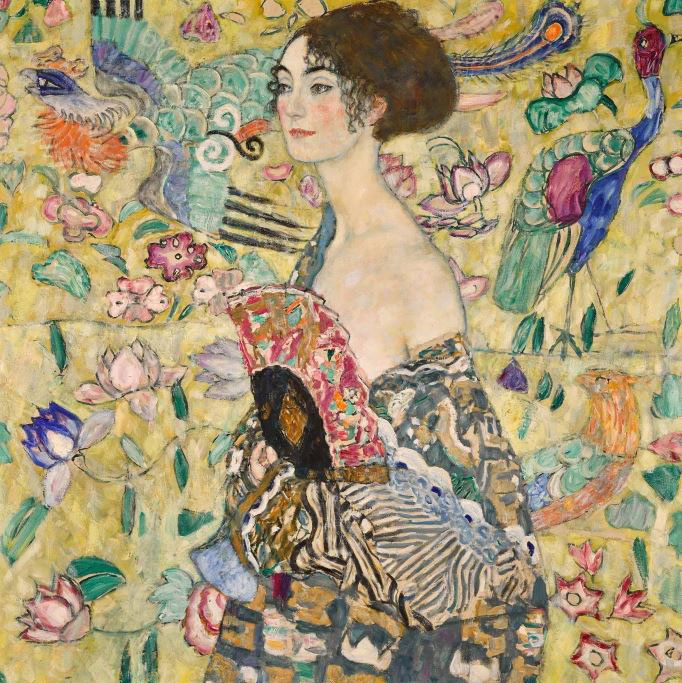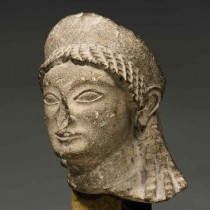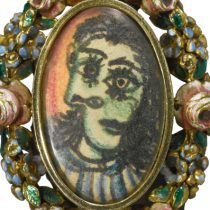“Dame mit Fächer (Lady with a Fan) is the last portrait Gustav Klimt created before his untimely death, when still in his artistic prime and producing some of his most accomplished and experimental works. Many of those works, certainly the portraits for which he is best known, were commissions. This, though, is something completely different – a technical tour de force, full of boundary-pushing experimentation, as well as a heartfelt ode to absolute beauty.”
Today, Sotheby’s reveals a work that is not only the star of the summer auction season in London, but also one of the finest and most valuable works of art ever to be offered in Europe.
Still standing on an easel in Gustav Klimt’s studio at the time of the artist’s unexpected and untimely death in February 1918, Dame mit Fächer (Lady with a Fan) – a beautiful, rich and alluring portrait of an unnamed woman – brings together all the technical prowess and creative exuberance that define Klimt’s greatest work.
The last portrait Klimt painted, Dame mit Fächer is also among his finest works, created when he was still in his artistic prime, and at a moment when the ‘formality’ of his earlier commissioned work gives way to a new expressivity – an ever-deeper, ever-more joyful immersion in pattern, colour and form, which – while clearly influenced by his contemporaries Van Gogh, Matisse and Gauguin – became something entirely different in his hands.
Similarly, while the slightly earlier works of Klimt’s famous ‘golden period’ – led by the iconic portrait of Adele Bloch-Bauer I of 1907 – see their sitter presented icon-like, amid a tapestry of golden shapes, here the sitter almost dissolves into the background, the soft patterning of the woman’s skin repeated in the pale-yellow background.
Klimt first started work on Lady with a Fan in 1917, by which time he was among the most celebrated portraitists in Europe: commissions came thick and fast, for which he was able to command prices far higher than any of his contemporaries. But this was a rare work painted entirely in the pursuit of his own interests. Full of freedom and spontaneity, it reflects Klimt’s joy in painting it and in celebrating beauty in its purest form. It also reveals his innovative approach. Traditionally, portraits were – and still are – painted in the eponymous ‘portrait (or vertical) form’. Here, Klimt returns to the square format that he used for his avantgarde landscapes earlier in the century, giving this painting a uniquely ‘modern’ edge.
Klimt also here gives full expression to his complete fascination with Chinese and Japanese art and culture. Luscious, silken kimonos and Chinese robes are known to have been his dresswear of choice, and his home abounded with beautiful objects from the East. Egon Schiele, a regular visitor, describes it like this: ‘the sitting room, [was] furnished with a square table in the middle and a large number of Japanese prints covering the walls… and from there into another room whose wall was entirely covered by a huge wardrobe, which held his marvelous collection of Chinese and Japanese robes.’
In Dame mit Fächer, Klimt draws principally on Chinese motifs: the phoenix (symbol of immortality and rebirth, good fortune and fidelity) and lotus blossoms (symbols of love, happy marriage and/or purity). Meanwhile, his flattening of the background and juxtaposition of patterns reflects his deep interest in Japanese woodblock prints.
The painting was acquired shortly after Klimt’s death by Viennese industrialist Erwin Böhler. The Böhler family, including Erwin’s brother Heinrich and his cousin Hans, were close friends and patrons of both Klimt and Egon Schiele. They vacationed with Gustav Klimt on the Attersee, a lake near Salzburg that was the inspiration for many of the artist’s most important landscapes and can be seen in photographs together. In 1916 Erwin purchased the Litzelberg – a small island in the lake immortalised in Klimt’s paintings. An important supporter of the arts, Erwin Böhler commissioned leading architect Josef Hoffmann to decorate the rooms of his apartment in the Palais Dumba in Vienna where the painting hung in the Music Room alongside Klimt’s landscapes Waldabhang in Unterach am Attersee and Presshaus am Attersee which were also part of his collection. The work eventually passed to Heinrich and then, upon his death in 1940, to Heinrich’s wife Mabel.
By 1967 it was in the collection of Rudolf Leopold, who is known to have purchased a large group of Schiele drawings from Mabel Böhler in 1952 and may also have acquired this work from her. Dame mit Fächer was last offered for sale nearly thirty years ago in 1994, when it was acquired by the family of the present owner. Most recently it was the subject of an important exhibition at the Belvedere in Vienna where it was reunited with and shown alongside Klimt’s other great, late masterpieces.
The exhibition of the painting in Sotheby’s New Bond Street galleries later this month will mark a major moment for Klimt lovers in London, with three major portraits by the artist on view simultaneously in the capital for the first time ever. (The other portraits, Hermine Gallia of 1904 and Adele Bloch Bauer II of 1912, are currently on view in the National Gallery’s much-acclaimed show, ‘After Impressionism’.)
One of only a small number of portraits by Klimt still in private hands, Lady wi th a Fan will be offered in Sotheby’s marquee Modern & Contemporary Evening Auction in London on 27 June with an estimate in the region of £65 million ($80 million).
The appearance of this major work at auction marks an important moment for the market: not only is the painting the most valuable ever to have been offered at auction in Europe, it also now joins the ranks of the most valuable portraits – of any era – ever to have come to auction.
Klimt himself also sits in the select pantheon of artists to have achieved over $100m at auction – his Birch Forest having sold as part of the Paul G. Allen Collection last year for $104.6m. While that was a landscape, only one portrait by Klimt of this calibre has ever appeared at auction before: Portrait of Adele Bloch-Bauer II, from 1912, which made $87.9m in 2006.
Dame mit Fächer also joins a strong sequence of spectacular works to have starred in Sotheby’s Marquee Seasons in London: most recently René Magritte’s L’empire des lumières (sold for £59.4m / $79.8m, March 2022) and Wassily Kandinsky’s Murnau mit Kirche II (sold for £37.2m / $44.9m, March 2023).
The star offering in London this June, Dame mit Fächer will feature large in what is set to be a very special season of auctions, exhibitions and events at Sotheby’s this summer, much of which will be focussed around the subject of portraiture – timed to celebrate the much-anticipated reopening of the National Portrait Gallery in London.
Accordingly, Sotheby’s marquee Modern & Contemporary Evening Auction on 27 June will include a strong grouping of portraits – by leading artists such as Alberto Giacometti, Edvard Munch, Leonor Fini, Elizabeth Peyton and Kerry James Marshall – all to be presented in a special sequence (‘Face To Face’) dedicated to this long but totally timeless and multi-faceted tradition.
That too will be complemented by a special exhibition of masterpieces from Chatsworth House in Derbyshire, one of Britain’s finest stately homes, featuring works by Rembrandt, Sir Joshua Reynolds, Lucian Freud and Michael Craig-Martin, many of them never seen in the UK outside of Chatsworth before.
Portraits from Chatsworth – A Loan Exhibition will be on public view from 30 May to 4 July. Meanwhile, Klimt’s Dame mit Fächer, and other highlights from Sotheby’s suite of flagship June sales will be on view to the public from 20 to 27 June. Both exhibitions are free and open to all.





